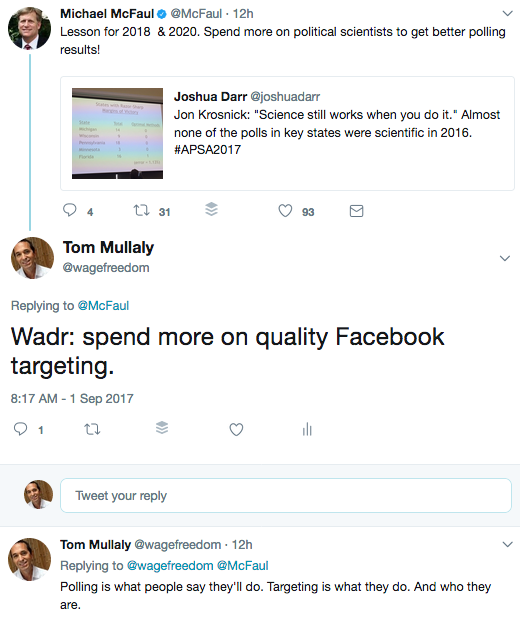 From my talks with clients I’ve concluded that there’s a huge gap between what ordinary people (including business owners) assume about online marketing generally (and paid CPC/CPM specifically), and the improved methods new marketing technology offers to promote whatever you, a client, or even a political candidate needs to get in front of people.
From my talks with clients I’ve concluded that there’s a huge gap between what ordinary people (including business owners) assume about online marketing generally (and paid CPC/CPM specifically), and the improved methods new marketing technology offers to promote whatever you, a client, or even a political candidate needs to get in front of people.
Not to be too hard on Michael McFaul, a former US Ambassador to Russia, but his tweet is another data point that shows how even academics can still be unaware of better ways of understanding large groups of people, and affecting their behavior.
Polling is analysis. I’d never suggest it should go away. But I don’t understand why people obsess so much over polls when we now have tools that combine analysis with marketing.
Spending money and effort on methods that use that combination are insanely effective. For proof look no further than the market cap of two of the largest companies the world has ever known: Google and Facebook.
You don’t think it’s the love of cat videos that brings in so much money do you?
If I had to use one word to describe the difference between old-school commercial advertising/political polls and modern methods, it is targeting.
Sure, basic ad targeting has existed for 100+ years. I’d argue that targeting today is so different from what it was before the rise of modern ad tracking that it deserves another term altogether.
Now I haven’t made a million bucks with Google Adwords, Facebook ads and mobile ad buys, but I have spent into 5-figures USD of my own money on online advertising for affiliate campaigns, and more for client work running campaigns using each of these traffic sources.
So, right or wrong, I at least have some hard-won opinions.
There are two reasons why targeting makes marketing a different game than it used to be.
One is that we can point our marketing campaigns at specific cross-sections of our overall audience.
A person over the age of 50 with an interest in old muscle cars might respond best to marketing angles for car insurance which would work far less well with a person for whom a car is just transportation, and vice versa.
We can now know exactly what segments of the people in front of whom we are putting ads are responding to our ads and taking the action we’re hoping they’ll take.
It’s hard to put a value on this granular control over messaging.
Second, with this control over message/audience matching we have the ability to refine our ad campaigns over time, tracking user responses and data then making new campaign iterations with the goal of improving conversions and our return on the money and time we invest to get those conversions.
So if you think about this little thumbnail sketch I’ve offered, you can see intuitively some of the power that target/refine/target/refine etc. as a process has.
In the event that I’ve piqued your interest, maybe I’ll go just a little deeper.
There is an old advertising adage that goes: ‘Half of all ad dollars are wasted. But not one knows which half.’ This has been totally turned on its head today.
Rather than just indiscriminately broadcasting ads via old media like radio or TV, you can—actually you MUST, because you can—know exactly who you are paying to put ads in front of.
You can target far more than demographic characteristics too! Any company selling you space for your ads like Facebook, or Google and other ad networks, has extensive data on the interests of users, their location, a ton of detail about the devices they’re using, the apps and websites they’re spending time on, etc.
If you’re a marketer certain segments of these users will respond to your campaign better than others. Naturally rather than spreading advertising dollars even across the entire spectrum of users, you’d like to spend money to reach people who respond best.
In practice, as I say this opens the door for you to create different campaigns for users with different combinations of demographic, interests, device, location, etc. details. With enough effort, over time you can construct (“Winning campaigns are made, not found” said a very smart affiliate marketer, or words to that effect) campaigns that maximize the effectiveness of your ad spend.
You’ll never be done refining and optimizing the ads you’re using and the targeting you continually test.
Today’s winning campaign might well be next month’s tired, ineffective set of banners that everyone has seen. But with a good offer, and the right amount of creativity and analysis of what is and isn’t working, you stand a chance–over time–of getting a positive return on what you spend on ads, even after accounting for the expense of your internal marketing team, or the agency you have managing your campaigns.
In the next section I’ll cover what a lot of people think is the very best use of your advertising spend nowadays.
1000% ROI–and even more–is attainable with this type of paid campaign, and there is virtually no business that shouldn’t be testing it in 2017. Do you know what it is?